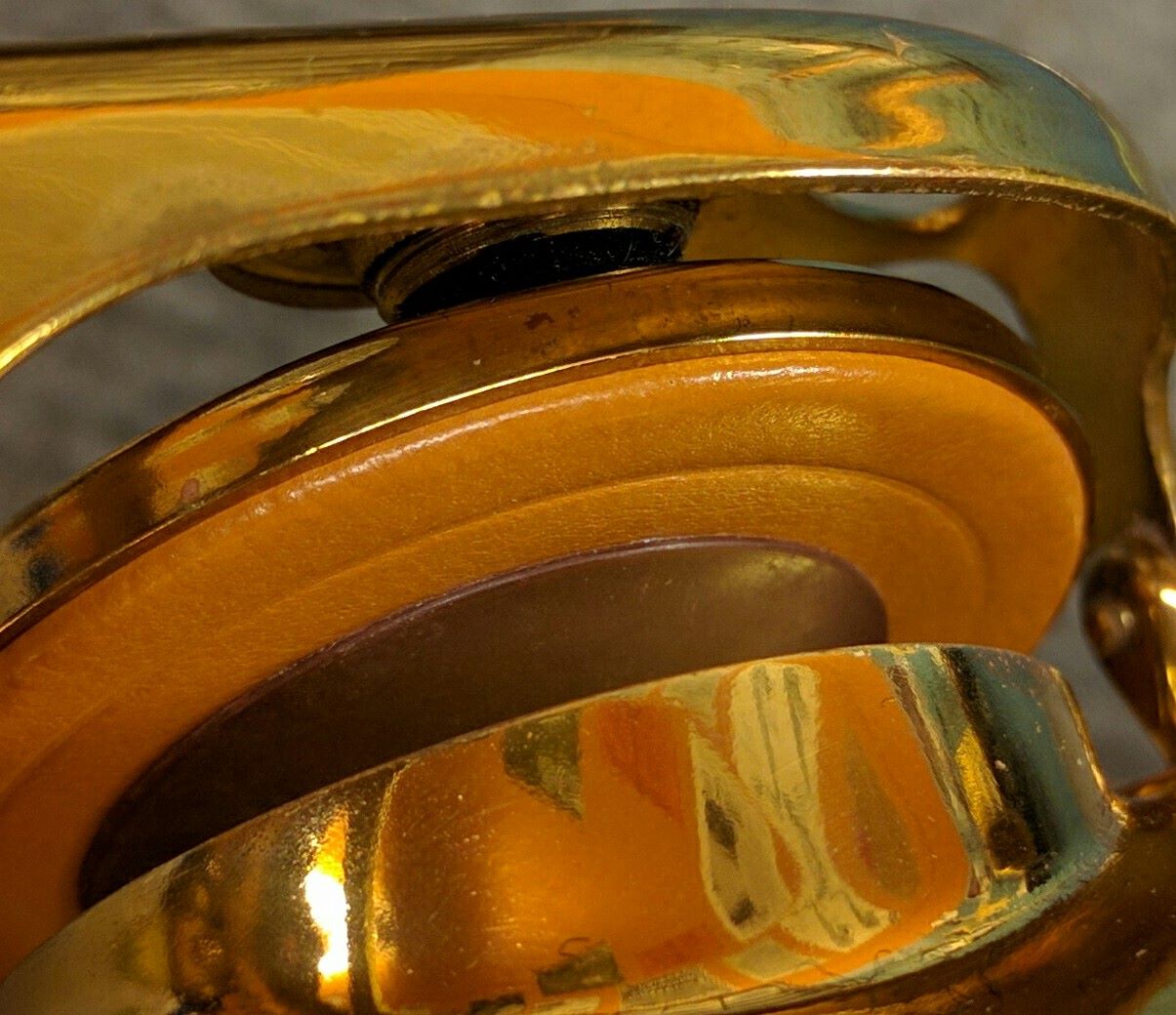This article is designed to give you some background on how installing saxophone pads can work. If you are learning repair, this can help teach you how to do it. If you are an interested consumer, this can teach you a bit about why replacing a pad isn’t cheap when its done well and how to understand what you are seeing in your own saxophone.
Saxophone padwork is a huge subject, and I am constantly amazed by a few things I notice in my job:
- My padwork continues to evolve- sometimes week over week, even after over a decade as a full-time+ saxophone repairman.
- There are almost as many ways to do it right as there are to do it wrong.
- I’ve seen excellent padwork done in ways that I cannot replicate.
So, this is a guide written about how I do padwork in December of 2015. It will be slightly different next month, and likely quite different in 10 years. It may work well for you, it might not. In the end, you’ll discover your own particular way of doing things that works best for you. Scroll all the way down to the bottom for some links to other articles and videos around the web about this subject.
Fair warning: This is a huge article, and it will take a lot of your time to learn this. If you are planning on skimming it because you’ve got other things to do and you just want to quickly learn about saxophone padwork, I respectfully submit you should stop here and use your time more wisely elsewhere. You can’t learn this quickly or easily and get results any more than you could with surgery or home building. If you don’t take the full measure of time necessary and never rush, you’ll get poor results, so you might as well save all of your time and just skip it if you are trying to learn to do this to save money or time- because you won’t, unless you own a hundred saxophones (in which case you probably don’t need to save money, right?). This is also an article written without much hand-holding, so go slow and go back over a sentence if it doesn’t make sense. Maybe even come back and read it again after you’ve done a few horns to see if something that didn’t resonate before now does. And of course, feel free to ask questions and if I can come back and edit this to make it clearer, I will.
Also it is important to note: what I am talking about here is considered “floating”. I use enough adhesive so that the pad floats on a thin bed of adhesive in the pad cup- ideally the pad ends up flat and parallel to the edges of the pad cup if you did everything right and things went your way- but with the allowance for minor adjustments to pad seal being able to be made just by heating the shellac and moving the pad independently of the key cup. The non-floating method (as often used at factories) is to use minimal adhesive just as a means to secure the pad to the key cup, and any adjustments are made by bending the key and/or making a fairly deep impression on the pad. While I consider it extremely important to get the geometry correct, I do not consider key bending an exact enough process post-factory (where they can control the shapes and relationships of the keys in a repeatable way during the build process) to get precise results, so I utilize a combination of “dry fitting” (key bending) and floating to get my final results.
Ok, so let’s get to it. What is installing and seating a saxophone pad?
The installation of a saxophone pad is the selection of an appropriately sized pad for the pad cup, followed by the application of the correct amount of a thermoplastic adhesive (usually natural shellac, synthetic shellac, or hot glue) on to the pad and/or pad cup and fitting of the pad evenly and symmetrically into the pad cup.
The seating of a saxophone pad is the heating of the installed key cup on the saxophone leading to a softening of the adhesive allowing the pad to move slightly in order to mate evenly and fully with the tonehole for a perfect all-around seal and the formation of an impression of the tonehole in the pad leather.
Sounds like a simple process, right?
This guide assumes that your horn is in good condition, that everything is as it should be with the body of the saxophone, that the keywork is well-fit and operating properly (and here’s why that is important), that the pad cup is cleaned out of all old adhesive, and that you are using high-quality materials and the appropriate tools. Therefore the only aspect of padwork that we are talking about is pad selection, adhesive application, and pad seating.
The list of what *might* be required to get a horn in such a condition can be extremely long, and you will be required to use your judgement as to whether your saxophone is in the proper order to seat a pad, or whether something else (dentwork, tonehole repair, body straightening, key fitting… the list goes on) is needed first to get the horn ready for padwork. When in doubt, get assistance from someone skilled in the craft, as leveling key cups can get messy fast if not done right.
So assuming that is all already done, the basic idea is:
- The key cup must be level, and the plane of the key cup must be parallel to the plane of the tonehole. It needs to be centered over the tonehole (though sometimes it can only get close, not perfect), level left to right, level front to back, and an appropriate height over the tonehole when level. How to do this will be its own article (or more likely, series of articles) eventually, which will be linked here.
- Select a pad that fits the key cup properly, which is a tight fit. Better a little too tight than a little too loose.
- Apply the correct amount of adhesive so that the thickness of the pad + the thickness of the adhesive = the distance from the tonehole to the inside back of the key cup when the key is level to the tonehole.
- Install pad in key cup.
- Seat pad.
The better you perform steps 1-3, the easier step 5 goes. When you do steps 1-3 perfectly, step 5 is easy and results in a long lasting pad. The longer step 5 takes you, the less life you will get out of that pad. The three preceding sentences are as important as anything else you will ever learn about saxophone repair.
So let’s get fine-grained about those steps.
Step One, leveling key cups relative to the tonehole.
Notice this article does not tell you HOW to do this- that will be a separate article later. So for now, if you don’t know how to do this, consult a professional.
You may want to consult a professional on this one. If it is your first time, consult a professional as a matter of course. I will write another large article on this topic eventually, because this is a big topic that is both extremely important and extremely easy to really mess up badly and permanently.
Ok, so having the pad cup level and straight and in the proper orientation is a prerequisite for doing good padwork. It can sometimes be pretty easy or already done for you if the horn was built well or repaired well in the past, or fiendishly difficult if the opposite is true. The idea is that the tonehole represents a flat plane, as does the inside back of the pad cup. When the key is installed on the saxophone and you close the key, these two planes need to be parallel at a point that is reasonable- that is, at a point that is equivalent to the thickness of your pad + a reasonable amount of adhesive.
You will need to be careful with this procedure to avoid bending the pad cup into a potato chip, avoid marring the key, avoid creating a bent/binding key in a hinge tube, and avoid creating a bent pivot rod. Stabilization of the key, reinforcement of portions you do NOT want bent, application of appropriate directional force to the part you DO want bent, and appropriate tools for the myriad situations you will be presented with are absolute requirements.
This is a huge subject in itself, and how to do this involves many different procedures which will get linked to below as I create the materials. In the meantime, when in doubt, consult a professional. This step can get messy fast, and it will be cheaper to pay a professional to do it right in the first place than to pay them to fix your mistakes. And don’t even think of doing this on a professional horn if you aren’t very good at it already.
The relatively easy bits:
- Leveling/straightening a pad cup.
- Centering the pad cup over the tonehole.
- Leveling the pad cup L/R over the tonehole.
The much harder bit:
- Adjusting the parallel height of the key cup over the tonehole. Depending on the type of horn, that can be .185″ + shellac or .160″ + shellac- with .185″ and .160″ being the two major industry standard pad thicknesses available. Some saxophones (Leblanc System, for example) actually originally took even thinner pads than what are commonly available today, and that will present a special problem. But most often, what you are dealing with is the aftermath of damage and/or bad/lazy past repairs where the repairer bent the key cup to fit their pad selection/adhesive amount rather than selected the right pad and used the right amount of adhesive for the horn.
The typical starting point for a vintage horn is a key cup shaped like a potato chip, off center, canted L/R, and bent into an improper (non-) parallel attitude by someone in the past using incorrect thickness pads. With modern saxophones or a saxophone that has not seen generations of repairers, it might only need a slight tweaking L/R or centering over the tonehole.
Notice this article does not tell you HOW to do this- that will be a separate article later. So for now, if you don’t know how to do it already, consult a professional.
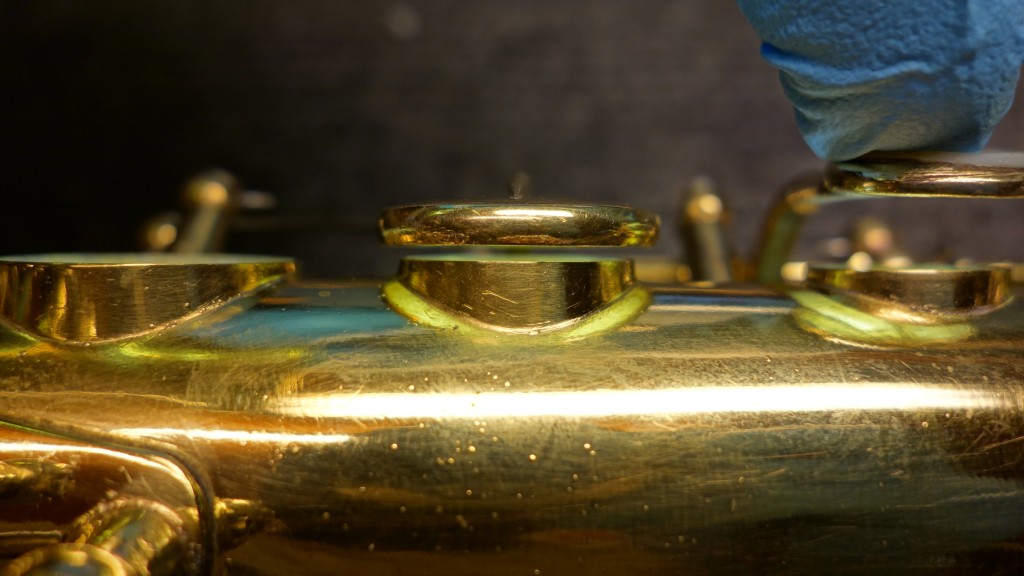
Step Two, pad selection.
You’ll want to be using a pad you are comfortable with, something high-quality and of the appropriate thickness.
Once you’ve chosen your brand of pad, you will want to have a selection of pad sizes to choose from. Pad sets are always inaccurate, not only because of inaccuracies in the making of the set to fit a range of saxophones (human error, manufacturing variances) but more importantly, unavoidably, always and forever because pads are slightly different from one to the next thanks to being made of felt and leather which are variable materials. In your 40.0mm size drawer, you will have pads ranging from 38.8mm to 40.3mm. Being able to sort through them and select a particular, individual pad that fits that particular, individual pad cup precisely is a necessity. If you can’t afford to have a large selection (which is quite expensive), at the bare minimum you will want to measure the interior diameter of your pad cups and order a few pads for each key cup in sizes around what you order. For instance, if I measure a pad cup to be 40.1mm, I would order a 39.5mm pad, two 40.0mm pads, and a 40.5mm pad. One of those should fit, and the rest go towards building your eventual full pad selection of at least 3 of every size. If you are a professional, you’ll stock a lot more and order early to avoid backorder trouble.
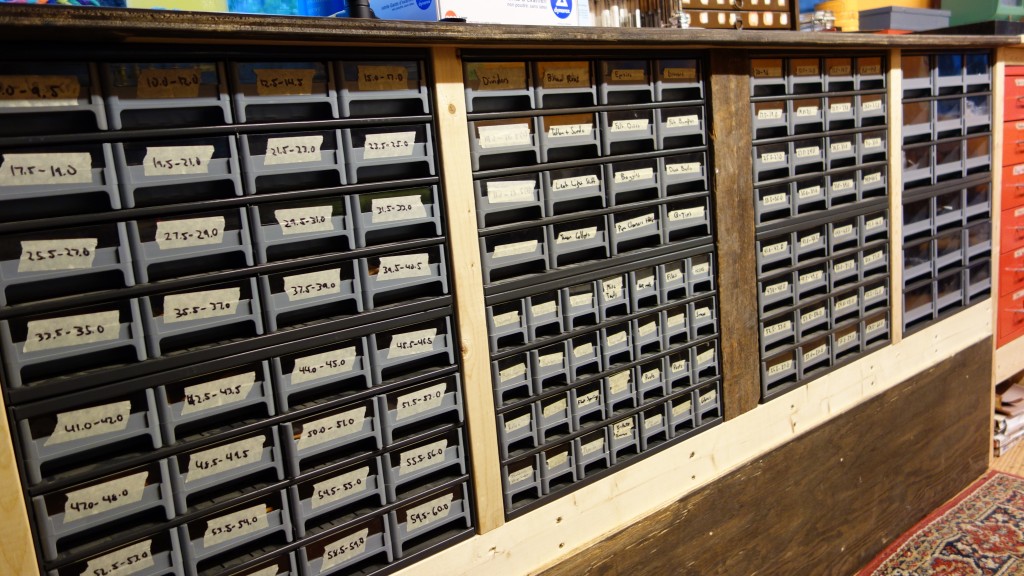
The pad you select should be a tight fit. Always err on the side of tight- the wrinkles in the leather can be ironed away if necessary (not common but it happens), and the felt will adjust itself a little bit. Loose means adhesive squeezes out the sides easily, which means that rather than evenly distributing itself between the pad and the key cup, the adhesive is much more easily made uneven during the seating process, leaving the pad like a table with a short leg. You’ll work twice as hard to get half as good a result (indeed, if that) when working with a pad that is not a firm enough fit. It is sometimes however still possible to get a good pad seat with a squirt or two of adhesive coming out of the side of the pad cup (indeed sometimes it seems to be unavoidable as pads nor keycups are not always perfectly circular), but this seems to be a lucky break rather than an expected hurdle to overcome.
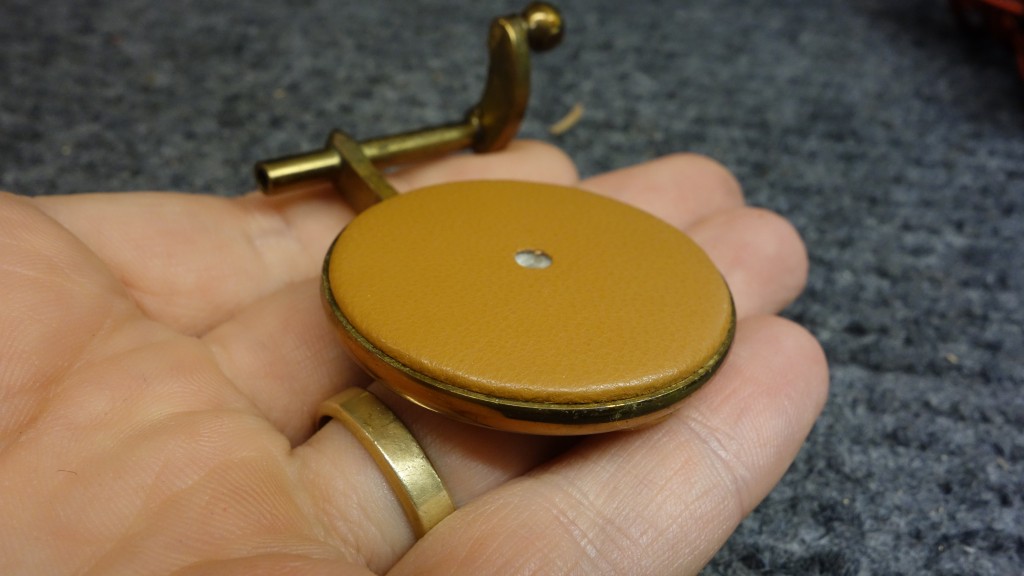
The way I select pads is to hold the key cup in my hand and find a perfectly fit pad out of my selection in my pad drawers. Sometimes I go through several pads of the same size before I find one I like. I don’t have any measurement lists for pad sizes for horns- the variability in pads and in horns makes them a moot point.
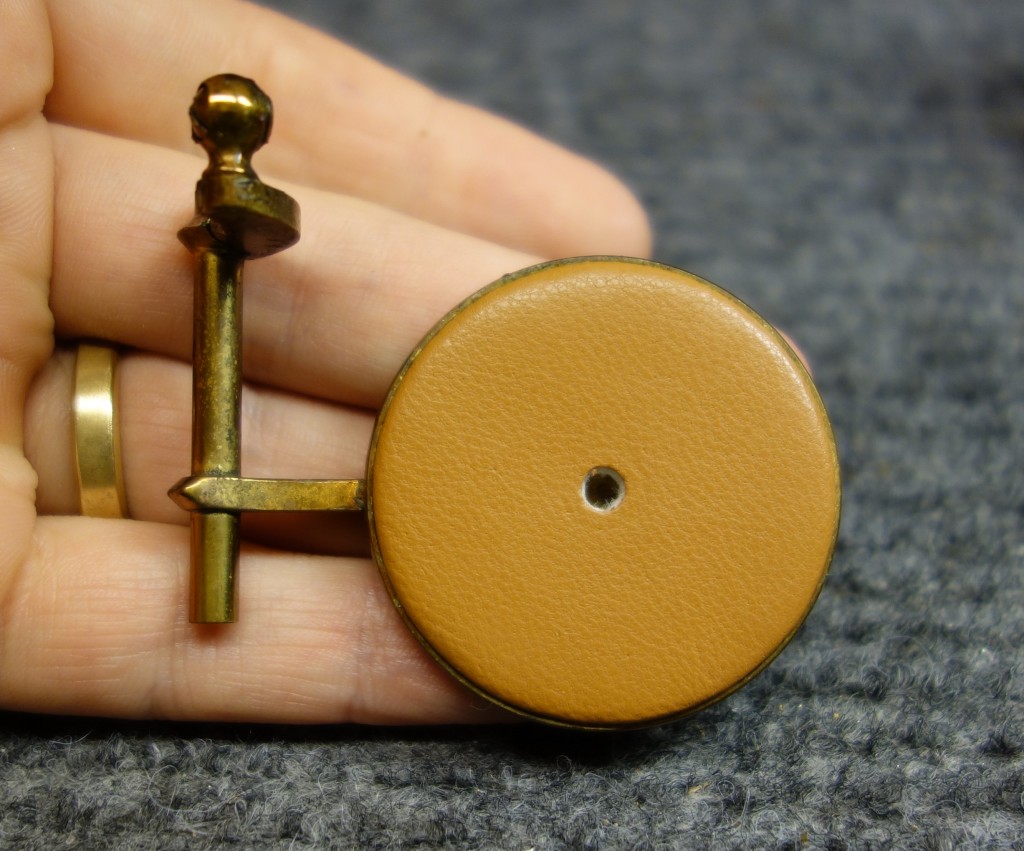
And if you are reading this thinking you’ve got a better idea for a saxophone pad, have at it. Just know that other people have been thinking the same thing for a hundred years and still here we are with pads that are basically the same as what Adolphe Sax would have used.
Step Three, application of adhesive.
If you want to see strangers yell at each other, ask a saxophone repair forum any question what adhesive is best for pad seating.
There are three usual suspects when talking about an adhesive for saxophone repair: natural shellac, synthetic shellac, and hot glue. There are varieties of each, and using a high-quality version is required. Through long process of selection and trying out most of what I could get my hands on, I have found that I personally like two types of adhesive: natural stick shellac I make myself from dewaxed flakes (I buy the stuff from Ferree’s Tools), and for a few occasions (notably using regular pads for Buescher saxophones with the Snap-On resonator system) I like a particular type of hot glue that is expensive and typically used for upholstery (and indeed the usual arguments leveled at hot glue apply to the dollar store type, and they are arguments I would agree with). Some things to consider when selecting an adhesive are melt temperature, plastic range (does it go from a runny liquid straight to glass hard or does it slowly congeal), and viscosity when melted.
Whatever your adhesive, the same ideas apply. Coverage between the back of the pad and the inside back of the pad cup needs to be very even with no air gaps. Most importantly, the amount of adhesive needs to be very precisely chosen to be exactly equivalent to the amount that, once melted, will make the pad sit level in the pad cup and seal evenly all the way around when the pad cup is parallel to the tonehole. This is the most important part of pad seating, and if done right is the majority of the seating process. If you get this right, everything else goes easily and your pads will seat well for a very, very long time. If you get it wrong, pad seating will be difficult and your results will leave much to be desired. It is better to take a pad out and try it again with a new pad than work against a mistake made in the amount of adhesive used. Sometimes, if you just installed the pad and you see that the adhesive amount was wrong and you haven’t messed with it much, you can take it out and either scrape off adhesive or add more to fix the mistake in adhesive application, but when in doubt just replace it. Saving $3 on a pad to have a pad job that is less than your best is not worth it.
I will put a brief text explanation here on how to apply shellac to a pad, but the video below is best to show the actual motions of applying it to the pad.
Brief explanation:
- Hold your pad in a way that is secure, easy to manipulate, and keeps your fingers away from the melted shellac, which when hot sticks to your finger as it imparts all of its heat energy and leaves you with a fairly painful and very inconvenient blister. I use a pin vise stuck into the side of the pad “below the waterline” where it is not visible when the pad is in the pad cup.
- Hold your pad near your heat source- I use a 00 tip on an acetylene-air torch, some people use alcohol lamps- and with the shellac in one hand and the pad in another, start heating the shellac.
- As it is about to drip, paint the pad from the outer rim inwards. Repeat until the pad is evenly covered, taking extra care to make sure that the middle portion of the pad has coverage that is level with the outer ring of leather.
- When you’ve got the amount you want on there, use a bit of finesse to flip it over on a bench anvil and level the shellac. It won’t stick. You should now have a pad that has a flat and even disc of shellac adhered to the back- and if you got everything right, its the exact amount you need to have the pad sit level in the pad cup and seal perfectly.
The amount of shellac will vary, but it will usually add somewhere around the thickness of a business card, plus or minus, to the pad when its done. This doesn’t seem like a lot, but it really is. Imagine a leak that you could slide a business card through! A leak you couldn’t slide a human hair through is still a huge leak.
Remember to keep the pad cup shape in mind when deciding how much shellac to apply. While I advocate applying the shellac in a way that ends up with a level disc on the back of the pad, once you install it in the key cup it should conform to and fill the key cup, which is usually domed and thus will end up with more shellac in the middle than on the edges. A highly domed keycup will take a surprising amount of shellac!
Step Four, install pad in key cup
I keep trying this different ways, and it doesn’t seem to be better one way or another just yet, so here is how I am doing it as of right now. Though I have a feeling that at some point I will come back here and edit this, because I might be missing something.
With the key installed on the horn, put the pad in the key cup. If your shellac is how it should be, it will slide right in to the pad cup and be held there by the snugness of the pad fit even though the shellac is not melted anymore and the pad cup is cold. It should be sitting high since the shellac is not melted to conform to the key cup yet, this is normal.
Most people seem to do this differently. Either they apply adhesive to the pad cup in addition to the pad itself, or heat it before putting in the pad. I’ve tried it, but so far I see no reason to heat the cup before I am ready to do the actual seating. Maybe I am missing something.
Step Five, seat the pad.
Ok, here is the major rabbit hole. Due to variances in the pads themselves (remember how I feel about pad sets?), variances in how exactly each pad cup takes heat, variances in how exactly the shellac was applied, variances in how you do whatever you do from one pad to the next, this will always be a slightly different experience each time and while you can get very, very good at it, it will never become easy. You will always have to work at it, pay attention, take your time, and stay humble. A leak is a leak, whether you’ve been seating pads for 2 weeks or 20 years. This is also the part where there are many ways to do it. So here is how I currently try to do it.
At this point, you have made sure that your key cups are straight and level and that the cups are level and centered over the tonehole as much as possible. You should have ensured that the plane of the pad cup is sitting parallel to the plane of the tonehole at an appropriate distance (thickness of pad plus thickness of shellac). Depending on the type of horn, that can be .185″ + shellac or .160″ + shellac. You have put an appropriate amount of shellac on on the correctly-fit pad. You have installed the key on the horn and put the shellacked pad in the key cup.
The basic idea here is that the pad is a gasket, and the adhesive is a gimbal. Heat the adhesive, gimbal the pad into position so that when you close the pad cup, the pad seats evenly all around, hitting all at once, with minimal pressure. Airtight is what you want.
- Hold/mount the saxophone so that the pad cup is parallel to the floor. When the adhesive is soft, you don’t want gravity causing it to pool to one side.
- Engage the spring or springs that interact with the key in normal usage.
- Devise a way to actuate the key while heating/heated as it will be actuated in normal usage. For pearled keys this means something pushing on the pearl like your finger would- I use a drum stick stub. For keys that are sprung shut, this means the spring that is holding them shut. For spatula keys, this means by the spatula. For the F# and C# bar keys, this means actuating them with a stack key (I put a piece of loose cork on the bar for this procedure) like the F or B, respectively. You want to seat the pads with the same vectors of force that will be used to close them in actual usage. This means sprung and engaged as played. Even on a perfectly mechanically fit horn, the brass will flex and affect the geometry of the pad seat. If you doubt this, seat a low C unsprung, using the weight of the key to test your seat, and then engage the spring and actuate the key from the spatula and compare what it looks like.
- Gently heat the pad cup. This is something you’ll have to learn by “feel” over time. Different types of torches impart different amounts of heat and different pad cups absorb and spread the heat in different ways- and how exactly this happens is going to have a huge impact on how easily you can do your best work. I switched torches a few years ago and a repeat customer- one who at the time was not very well versed in repair- immediately exclaimed “whoa, what are you doing differently??”. I had changed literally nothing else, just my torch- it has that big of an impact. You want the cup to be evenly heated and at a speed that causes the adhesive to soften and melt all at once- not one side before the other, or one side hotter and therefore more liquid than the other. You want the same viscosity throughout the adhesive, and you don’t want it too hot (too liquid, expanding) or not hot enough (too viscous, pad flexes instead of moving on a bed of supple adhesive). Since the adhesive is hidden, getting this temperature right can be hard. I recommend practicing with junk pads with the key off the horn to start- you can heat the cup and then move the pad with your fingers to learn how things move.
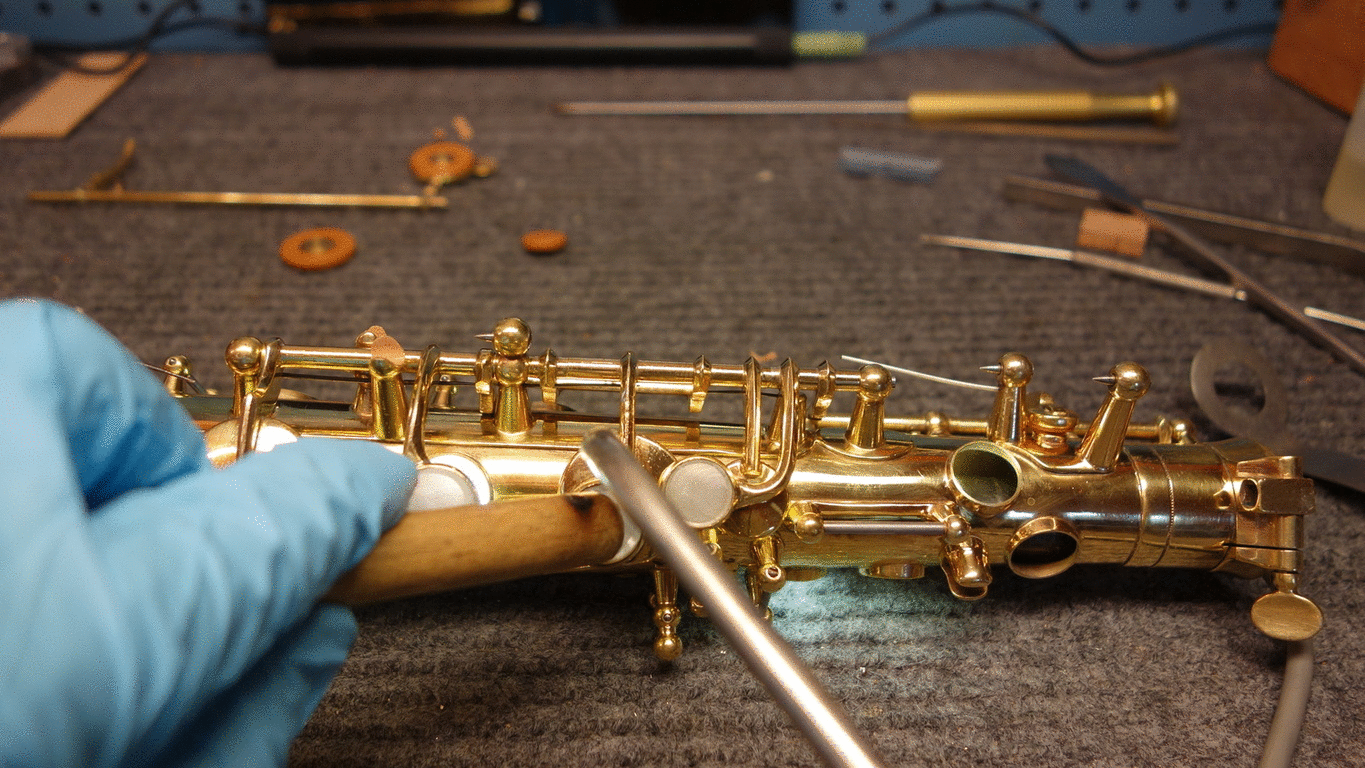
You will often have to move around obstacles like pearls or other keys. Just remember how the heat travels from your torch (kind of like a garden hose, but upwards due to heat rising rather than downwards due to gravity) and you can direct the heat in a way that warms the key cup evenly without burning anything. I recommend using a pearl protector (which you can make or purchase) until you get comfortable. - Once the pad cup is heated and the adhesive is appropriately soft, you can now move the pad into position. This can be done several ways, and depending on the situation I will either use the tonehole itself (less often) or a pad slick between the tonehole and pad (more often) to push the pad into the padcup and evenly spread the adhesive into a solid mass between the pad and the pad cup. If I can, I will rotate the pad in the pad cup a little bit as I press it down to evenly spread the adhesive around and ensure good adhesion to the pad cup. Don’t press too hard- you don’t want the adhesive to squirt out the sides or pool in the middle of the pad, causing a bulge. If you do get a bulge in the middle, you can use a pad slick to press it back to flat and level, but be gentle. You want your pad flat and level relative to the pad cup, with each side of the pad sticking out of the pad cup the same amount all the way around.
Be aware that using the pad slick to orient the pad against the tonehole is effectively adding thickness, so if you press too hard you will push the pad in the back more than in the front as it hits there first. Learning exactly how hard to press to orient the pad correctly when using a circular pad slick is just a matter of practice, and it will depend on the viscosity of your adhesive at the time and the pad fit and the geometry of that particular key. The important bit is to get the pad sitting proud of the key cup the same all the way around. - Now that your pad is bedded in the pad cup evenly all around, gently close the key against the tonehole. If you put too much adhesive in, the pad will hit in the back first, leaving the front open. If you put too little, the pad will hit in the front first, leaving a leak at the back. If you hit the Goldilocks zone, then your pad might actually be perfectly situated, hitting the tonehole all the way around at the same time and completely leak-free. If that wonderful circumstance has occurred, you can gently hold the pad cup shut against the tonehole while the adhesive cools, and skip to the final step. But more likely, you will….
- Take a look at how the pad sits and what leaks are there. If the leaks are all on one side L/R, either the pad cup or the bedding of adhesive is skewed, and depending on cause this can be fixed either by correcting the key attitude or by reheating the pad cup and re-orienting the pad on the bed of adhesive. If the leaks are all on one side front/back, either the bedding of adhesive is skewed or you have too much/too little adhesive. A small amount of front/back leakage can be corrected by reheating the pad and re-orienting it on the bed of adhesive, but if it is a lot, the pad must come out and the amount of adhesive must be corrected which often involves replacing the pad since it can be messy to remove and reinstall a pad. If the leaks are in several different places, you’ve either got a lumpy pad (common) or a non-level tonehole or uneveness in your adhesive (air bubble or just uneven spreading due to uneven/not enough/too much heat). An entire book could be written about what to do with uneven leaks, but I will simply encapsulate it thusly: you can choose what to do based upon what you think is happening. You can heat portions of the pad cup up and try to move portions of the pad with a pin vise or pad slick, you can try heating the whole thing and rotating it to re-even out the adhesive (this works out more often than you’d expect), you can heat a pad slick and iron the pad leather to try and get it to straighten out, you can take out the pad and try another one. What you do and how you do it will be specific to your circumstance and style of work, it is learned over time by doing, and it is a huge part of your success or failure at this work.The three following photos show how a pad can be oriented/floated using the typical pad slick tools. I took these photos with the key out of the sax so you could more clearly see what is happening.
- Once the pad is hitting evenly all around the tonehole all at once with light pressure, gently hold the pad shut while the adhesive cools. Keep the pad level relative to the ground as it cools. You can speed up the cooling process by damping a paper towel, folding it into a pad cup sized square, and holding it gently against the pad cup. The adhesive might move while cooling, so check for leaks again after everything is cooled. If there are leaks, go back and fix them.
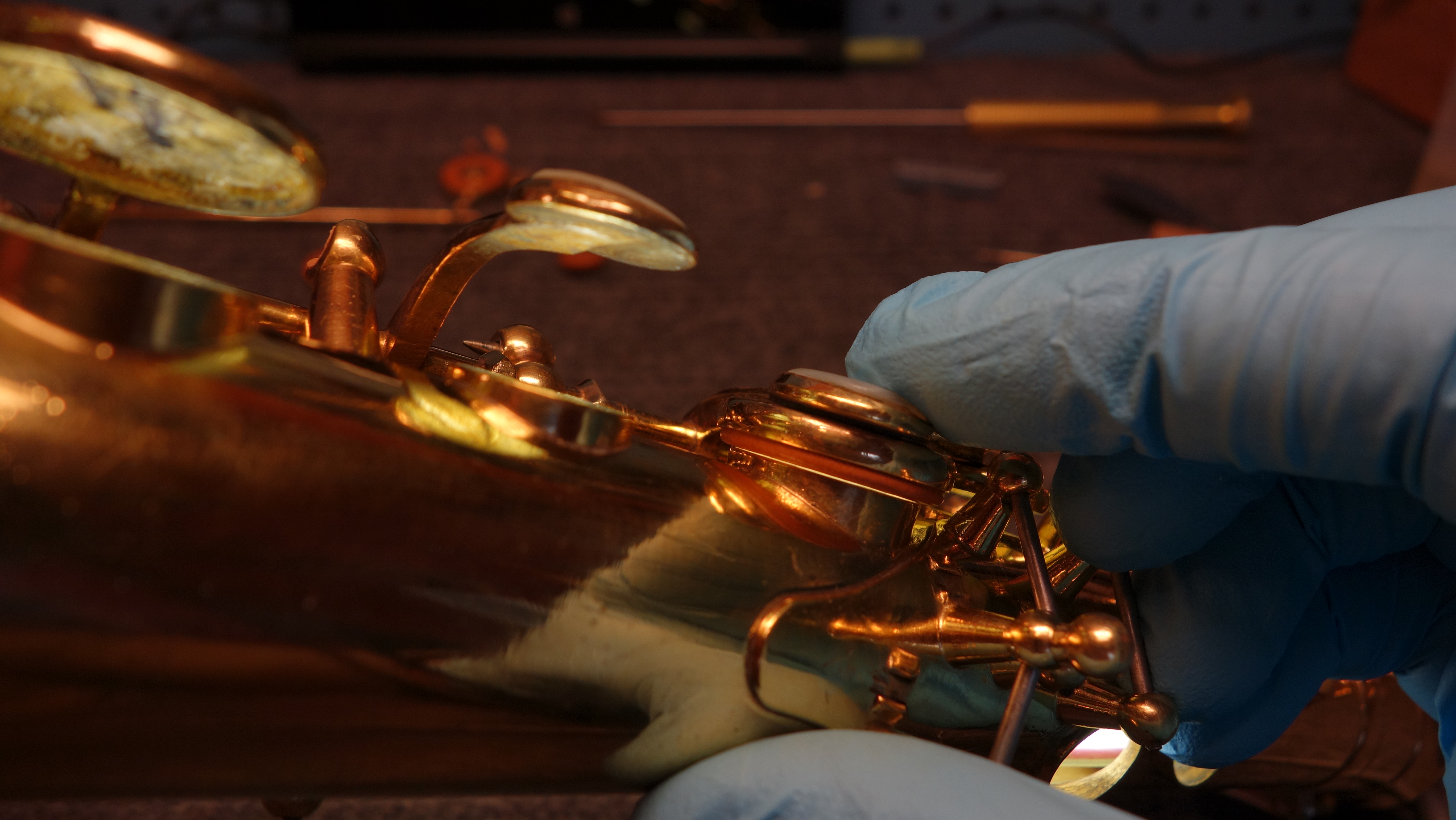
A well seated pad JUST BEFORE FULL CLOSURE showing exactly what you want to see: an even and straight sliver of light all the way around that disappears all at once as the pad shuts. This is a difficult test that is important to pass. This is a case of “good enough” never is.
Got it? Pad seated, sealing all the way around, evenly and easily with minimal pressure? Good job! Only 22 more to go. And of course there are the adjustment materials, and spring tensions, and key heights….
Don’t worry if padding takes a while for you to get good at. I’m still working on it, and I’ve been doing this full-time for over a decade. If its just not working, take it out and try another pad. Sometimes pads just don’t want to do what’s right.
Further resources:
1. Paul Coats, Pad and Cork Replacement, Saxgourmet.com: https://www.saxgourmet.com/pad
2. Stephen Howard, Testing for Leaky Pads, shwoodwind.co.uk: http://www.shwoodwind.co.uk/HandyHints/LeakyPads.htm
